|
JBL LE26 tweeters
Copyright 2007 ©
Troels Gravesen
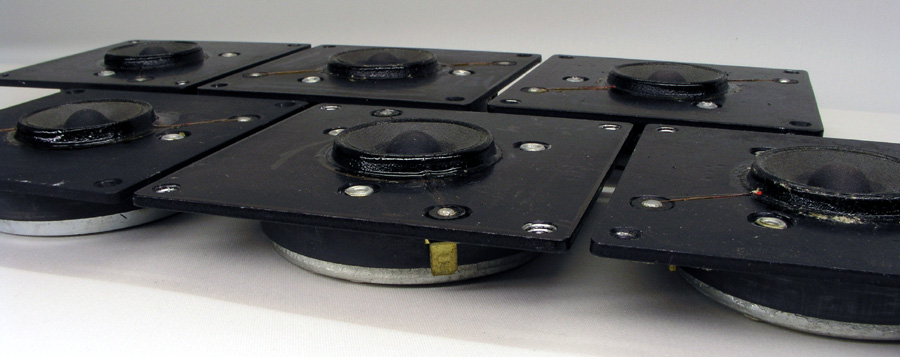
Sorry, no tweeters for sale. Use
eBay and search for JBL LE25 tweeters. These are the same as
LE26.
Current eBay
location.
"Why
do you buy all these old JBL tweeters?",
one of my friends asked, having noticed quite a few LE26
tweeters on my speaker shelves. "Well, hmm....I just
like to have a lot of them...", I replied. "OK,
fair enough", he said. I like that attitude. Anyway,
there's a good reason I've bought all the LE26 tweeters I
can find on eBay at sometimes 50 US$/pair, sometimes 80
US$/pair. I now have 5 pairs and that'll be it - I think
- and maybe I'll sell two pairs again, once tested and
fitted with waveguides.
1. The LE26 is quite sensitive; average
SPL/2.8V is around 94 dB. From 6-15 kHz sometimes up to
96-97 dB/2.8V.
2. It has a large membrane area, almost twice that of a
standard 1" dome, so it doesn't have to move much.
3. Membrane material is paper and I've found it
integrating well with e.g. Supravox drivers. Paper +
paper....
4. A waveguide can relatively easy be made to raise the
2-6 kHz region further, thus reducing distortion towards
point of crossover.
5. The LE26 is better than the LE25 - for some reason.
Only difference appears to be the colour of the paper
pulp used and coating of the surround fabric, extending
the frequency range from 13 kHz to 17 kHz and getting rid
of the 12-13 kHz peak of the LE25.
6. Last but not least, high-efficiency paper cone
tweeters are becoming rare as hen's teeth these days.
Initially these LE26 tweeters
were meant for the JA8008 high-efficiency 8" driver
while seeking for a modern alternative, eventually being
the Audax TW034 dome. The LE26 tweeters are obviously no
longer available but quite often for sale at eBay. By
coincident, the waveguide for the LE26 will also fit the
TW034 dome. However, having ten LE26 tweeters at hand
made a rare opportunity to report the spread in
performance of these tweeters. The JA8008 driver has a
midrange sensitivity of around 95-96 dB/2.8 V and tuned
to a system sensitivity of around 94 dB I needed more
than average sensitive tweeters to match this driver. I'd
rather have a large dome with an upper limit of 15 kHz
compared to most modern 1" domes doing well up to 20
kHz, but not particularly well below 3 kHz. Yes, I know
some domes go below even 1 kHz, but they don't sound good
- to my ears. The LE26 does well up to 15-17 kHz, more
than enough. The current trend of claiming 30-40 kHz is
ridiculous. We should rather worry about what our
tweeters do between 3 and 12 kHz where "treble"
is. Serious resonances between 15 and 20 kHz may disturb
lower registers, as the terrible alu dome introduced in
replacement of the LE 25 and 26. Actually this dome was
removed again due to complaints about performance. Later
on, a titanium dome was introduced doing better than the
alu dome, but they could have stayed with the paper cone
tweeter, which became very much out of fashion during the
late Seventies and Eighties.
|
.jpg) .jpg)
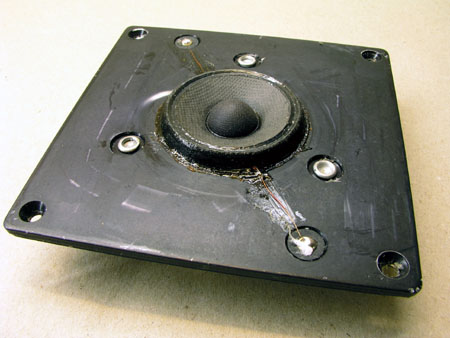 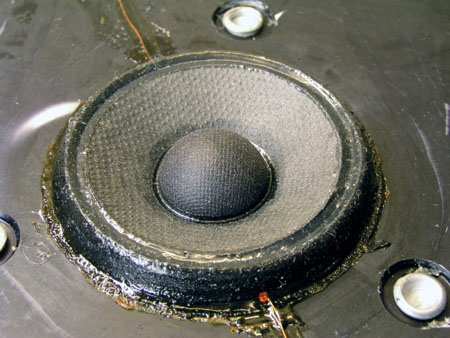
Instead of the LE25's
foam surround, the LE26 comes with a plastic
faceplate, slightly conveks, which is not such a
great idea. Inverting the faceplate makes a
better performance as seen here:
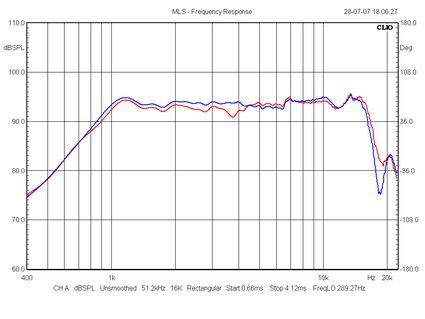
Red = conveks faceplate, blue = inverted
faceplate.
Design before performance, but not
a big deal. All measurements below are done with
inverted faceplate.
Removing the faceplate takes a gentle twist by a
screwdriver. Some sticky gue is used for mounting
the faceplate. Soak it in xylene, leave for a
minute or two and scrape it off. Take great care
not to damage the fragile wires to the voice
coil.
Measurements
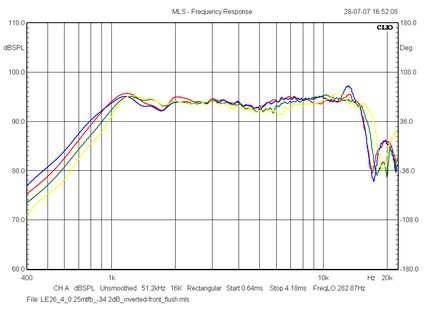 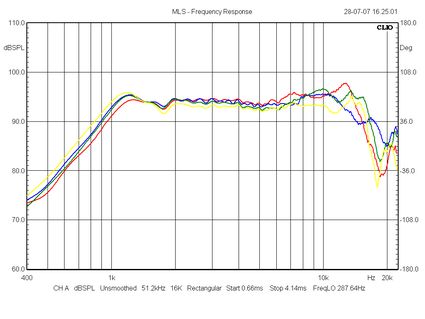
Left: Sample 1-4, SPL @
0.25 meter to front panel. Inverted faceplate,
flush-mounted on a 30 x 40 cm baffle.
Right: Sample 5-8, SPL @ 0.25 meter to front
panel.
Input signal adjusted to resemble response @ 1
meter distance, 2.8 V.
|
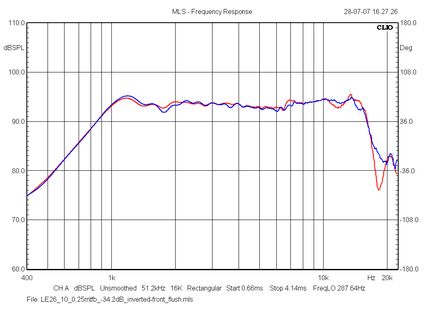 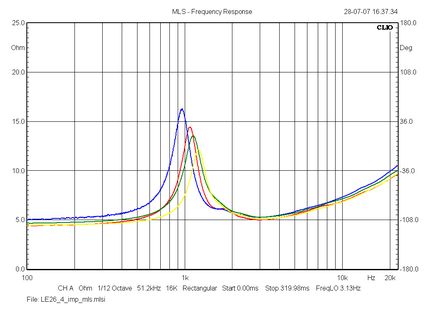
Left: Sample 9-10, SPL @
0.25 meter to front panel.
Right: Impedance of sample 1-4.
Input signal adjusted to resemble response @ 1
meter distance, 2.8 V.
|
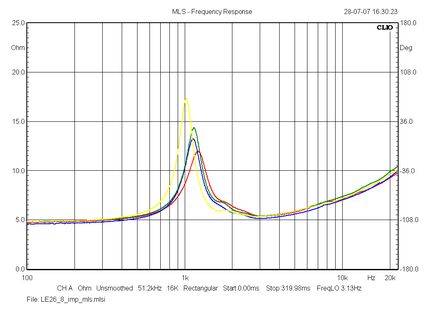 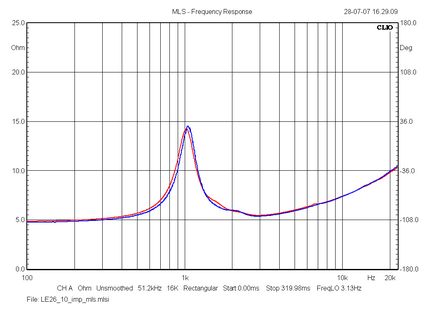
Left: Impedance of sample
5-8.
Right: Impedance of sample 9-10.
As can be seen from the graphs
above, these tweeters perform very well.
Impedance is surprisingly uniform, making
crossovers easy.
Also the frequency responses are excellent,
basically flat from 1.5 - 15 kHz. This is as good
as many modern tweeters.
|
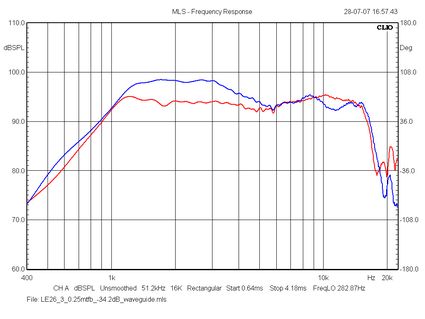 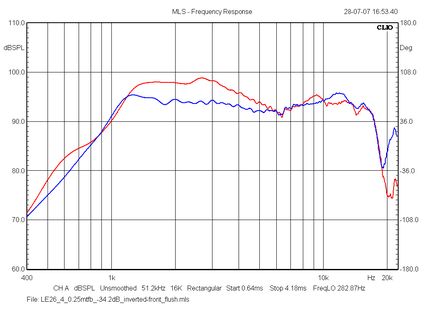
Left: Sample 3 fitted
with modified MCM waveguide.
Right: Sample 4 fitted with modified MCM
waveguide.
The waveguide will raise on-axis response from
around 1.2 - 6 kHz.
|
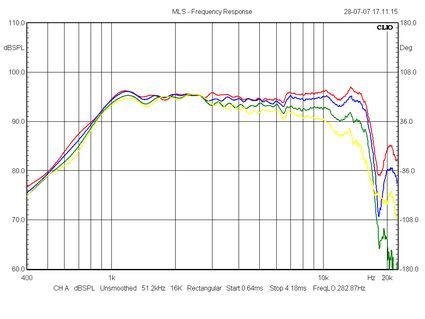 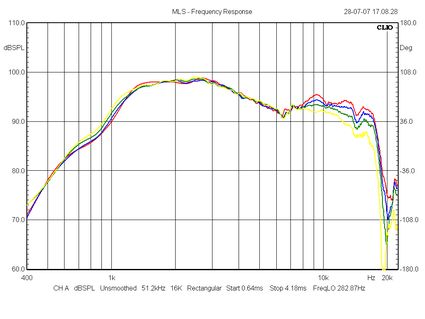
Left: Sample 9 at 0, 10,
20 and 30 deg.
Right: Sample 9 + waveguide at 0, 10, 20 and 30
deg.
As can be seen the waveguide makes a more even
power response compared to the un-modified
tweeter. "As-is", the roll-off starts
already at 3 kHz, where the LE26/waveguide
roll-off starts at 8 kHz and the loss at 30 deg.
off-axis at e.g. 15 kHz is around 5 dB compared
to 10 dB for the un-modified tweeter. Quite a
difference.
|
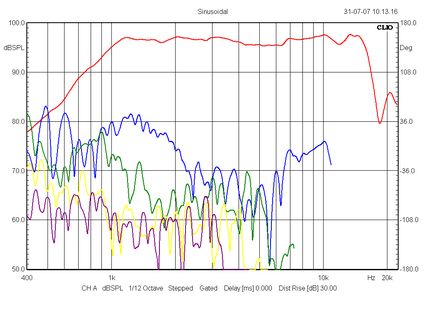 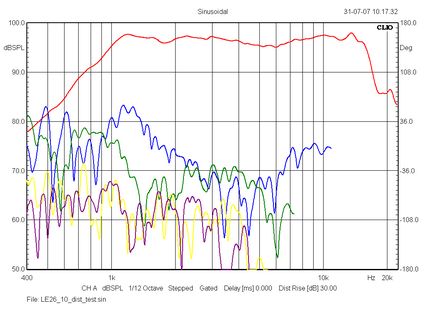
Left: Distortion test on
sample 9. Distortion curves raised 30 dB.
Right: Distortion test on sample 10. Distortion
curves raised 30 dB.
Blue = 2nd, green = 3rd, yellow = 4th, purple =
5th.
These measurement were done at 0.25 m distance
and with an average level of 97 dB, which makes
some 91 dB @ 1 m distance.
From 2-7 kHz the 2nd harmonic is some 25 dB + 30
dB = 55 dB below average level, rising to 50 dB
above 7 kHz. These are insignificant levels.
Previous measurements on the LE26 displayed
higher distortion levels, but were done at 6 dB
higher input, so the good question is at what
level these measurements are relevant. Playing
music at 90 dB is pretty loud, so these
measurements are well in accordance with my
subjective evaluation of sonic performance from
the LE26 tweeters.
|
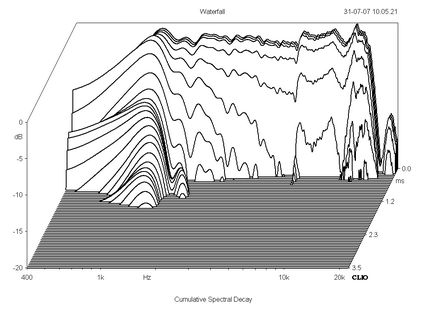 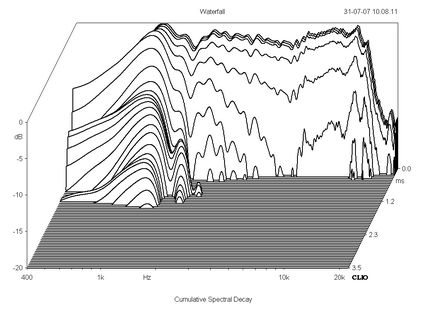
Left: Cumulative spectral
decay of LE26 sample 9.
Right: Cumulative spectral decay of LE26 sample
10.
I'm pleased to see these graphs, displaying a
clean decay above Fs.
|
.jpg) .jpg)
Fitting the MCM waveguide
to the LE26 tweeter takes a simple flange, here
made from 4 mm MDF. Dimensions seen below. As can
be seen from the photo to the right, the tweeter
corners were cut off and smoothed in a lathe.
|
.GIF)
No longer available.
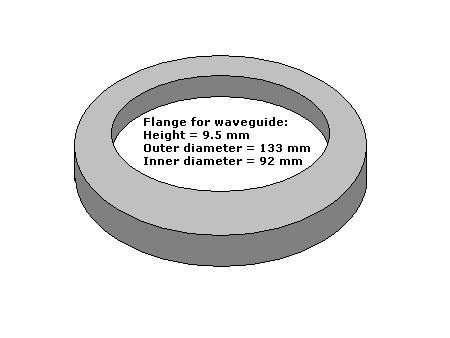
Another
flange for the MCM waveguide is needed. Dimensions seen
above.
.jpg) .jpg)
.jpg)
You
need a lathe to do this. The hole for the tweeter
diaphragm is 43 mm in diameter.
.jpg) .jpg)
|